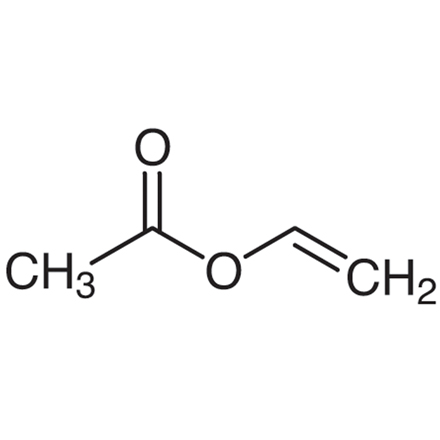Published TCIMAIL newest issue No.197
Maximum quantity allowed is 999
Bitte wählen Sie die Menge aus.
CAS RN: 108-05-4 | Produkte #: A0045
Vinyl Acetate Monomer (stabilized with HQ)

Reinheit: >99.0%(GC)
Synonyme
- Acetic Acid Vinyl Ester Monomer (stabilized with HQ)
Produktdokumente:
| Einheit | Stückpreis | Belgien | Japan* | Menge |
|---|---|---|---|---|
| 500ML |
18,00 €
|
29 | ≥100 |
|
*In Belgien verfügbare Lagerbestände werden in 1 bis 3 Tagen geliefert.
*In Japan verfügbare Lagerbestände werden in 1 bis 2 Wochen geliefert. (unter Ausschluss von regulierten Artikeln und Trockeneislieferungen).
| Artikel # | A0045 |
| Reinheit / Analysenmethode | >99.0%(GC) |
| Summenformel / Molekülmasse | C__4H__6O__2 = 86.09 |
| Physikalischer Zustand (20 °C) | Liquid |
| Lagerungstemperatur | Room Temperature (Recommended in a cool and dark place, <15°C) |
| Zu vermeidende Bedingungen | Light Sensitive,Air Sensitive |
| CAS RN | 108-05-4 |
| Reaxys Registrierungsnummer | 1209327 |
| PubChem-Stoff-ID | 87561748 |
| Spektrale Daten (AIST) Link | 1299 |
| Merck-Index (14) | 9992 |
| MDL-Nummer | MFCD00008713 |
Spezifikation
| Appearance | Colorless clear liquid |
| Purity(GC) | min. 99.0 % |
| NMR | confirm to structure |
Eigenschaften
| Schmelzpunkt | -93 °C |
| Siedepunkt | 72 °C |
| Flammpunkt | -8 °C |
| Spezifisches Gewicht (20/20) | 0.93 |
| Brechungsindex | 1.40 |
| Löslichkeit in Wasser | Slightly soluble |
| Löslichkeitsgrad in Wasser | 25 g/l 20 °C |
| Löslichkeit (mischbar mit) | Ether, Alcohol |
| Löslichkeit (löslich in) | Chloroform, Acetone |
GHS
| Piktogramm |



|
| Signalwort | Gefahr |
| Gefahrenhinweise | H332 : Gesundheitsschädlich bei Einatmen. H319 : Verursacht schwere Augenreizung. H373 : Kann die Organe schädigen bei längerer oder wiederholter Exposition. H341 : Kann vermutlich genetische Defekte verursachen. H351 : Kann vermutlich Krebs erzeugen. H335 : Kann die Atemwege reizen. H225 : Flüssigkeit und Dampf leicht entzündbar. |
| Sicherheitshinweise | P260 : Staub /Rauch/ Gas/ Nebel/ Dampf/ Aerosol nicht einatmen. P210 : Von Hitze, heißen Oberflächen, Funken, offenen Flammen und anderen Zündquellen fernhalten. Nicht rauchen. P233 : Behälter dicht verschlossen halten. P201 : Vor Gebrauch besondere Anweisungen einholen. P280 : Schutzhandschuhe/ Schutzkleidung/ Augenschutz/ Gesichtsschutz tragen. P370 + P378 : Bei Brand: Trockensand, Löschpulver oder alkoholbeständigen Schaum zum Löschen verwenden. |
Verwandte Gesetze:
| EC-Nummern | 203-545-4 |
| RTECS # | AK0875000 |
Transportinformationen:
| UN-Nummer | UN1301 |
| Klasse | 3 |
| Verpackungsgruppe (DOT-AIR) | II |
| HS-Nr. (Import / Export) (TCI-E) | 2915320000 |
Anwendung
Acetylation of Alcohols via Biotransformation using Acetylating Reagents

References
- 1)Regioselective Lipase-catalyzed Acylation of 4,6-O-benzylidene-α-and-β-D-pyranoside Derivatives Displaying a Range of Anomeric Substituents
- 2)On the Regioselective Acylation of 1,6-Anhydro-β-D-and L-Hexopyranoses Catalyzed by Lipases: Structural Basis and Synthetic Applications
- 3)Regioselective Acylation of Polyhydroxylated Natural Compounds Catalyzed by Candida Antarctica Lipase B (Novozym 435) in Organic Solvents
- 4)Protection for the Hydroxyl Group, Including 1,2-and 1,3-Diols
- P. G. M. Wuts, in Greene’s Protective Groups in Organic Synthesis, 5th ed., ed. by P. G. M. Wuts, John Wiley & Sons, Inc., Hoboken, New Jersey, 2014, Chap. 2, 17.
Anwendung
Acetylation of Alcohols via Transesterification using Acetylating Reagents

References
- 1)Acylation of Alcohols and Amines with Vinyl Acetates Catalyzed by Cp*2Sm(thf)2
- 2)Protection for the Hydroxyl Group, Including 1,2- and 1,3-Diols
- P. G. M. Wuts, in Greene’s Protective Groups in Organic Synthesis, 5th ed., ed. by P. G. M. Wuts, John Wiley & Sons, Inc., Hoboken, New Jersey, 2014, Chap. 2, 17.
Anwendung
Acetylation of Alcohols using Acetylating Reagents and Acid Catalysts

References
- 1)Molecular Iodine Catalyzed Selective Acetylation of Alcohols with Vinyl Acetate
- 2)Molecular Iodine in Isopropenyl Acetate (IPA): A Highly Efficient Catalyst for the Acetylation of Alcohols, Amines and Phenols under Solvent Free Conditions
- 3)Protection for the Hydroxyl Group, Including 1,2- and 1,3-Diols
- P. G. M. Wuts, in Greene’s Protective Groups in Organic Synthesis, 5th ed., ed. by P. G. M. Wuts, John Wiley & Sons, Inc., Hoboken, New Jersey, 2014, Chap. 2, 17.
Anwendung
Rhodium-Catalyzed Cross-coupling of Organoboron Compounds with Vinyl Acetate

Typical procedure: Under nitrogen atmosphere, a mixture of an arylboron compounds (0.50 mmol), [RhCl(cod)]2 (6.2 mg, 13 µmol), DPPB (11.7 mg, 28 µmol), and K3PO4 (320 mg, 1.5 mmol) is diluted with toluene (2.0 mL). Alkenyl acetate (1.1 or 2.5 mmol) and tert-amyl alcohol (0.55-1.5 mmol) are added into the resulting suspension at room temperature. The mixture is stirred at 100℃ for 24 h and then diluted with hexane (2.0 mL) or EtOAc (2.0 mL). After the filtration through a Celite pad, solvent is removed from the filtrate under reduced pressure. The residue is purified with a flash column chromatography (EtOAc-hexane) to give the desired product.
References
PubMed Literatur
Artikel / Broschüren
TCIMail
Produktdokumente (Hinweis: Für einige Produkte sind keine Analysediagramme verfügbar.)
Sicherheitsdatenblatt (SDB)
Bitte wählen Sie Sprache.
Das angeforderte SDB ist nicht verfügbar.
Bitte Kontaktieren Sie uns für mehr Informationen.
Spezifikationsdokumenten
AZ & andere Zertifikate
Bitte geben Sie die Lotnummer ein
Falsche Chargennummer wurde eingegeben. Bitte geben Sie nur 4-5 alphanumerische Zeichen vor dem Bindestrich ein.
Muster-AZ
Dies ist ein Muster-AZ und repräsentiert möglicherweise nicht eine kürzlich hergestellte Charge des Produkts.
Ein Muster-AZ für dieses Produkt ist zur Zeit nicht verfügbar.
Analytische Diagramme
Bitte geben Sie die Lotnummer ein
Falsche Chargennummer wurde eingegeben. Bitte geben Sie nur 4-5 alphanumerische Zeichen vor dem Bindestrich ein.
Das angeforderte Analysediagramm ist nicht verfügbar. Wir entschuldigen uns für die Unannehmlichkeiten.





